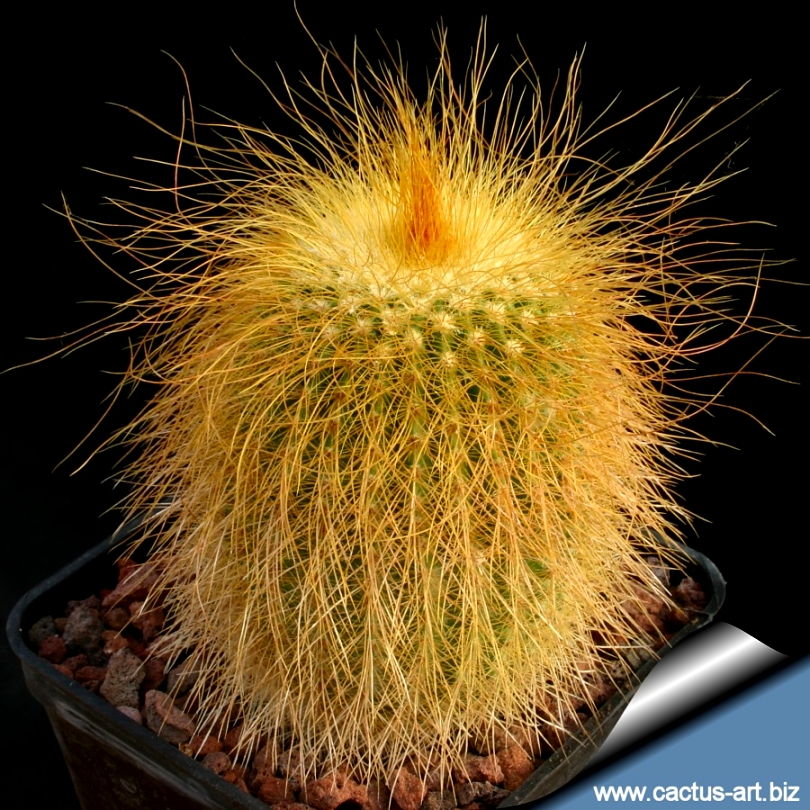|
|
|

A juvenile Notocactus leninghausii
This species has bristly golden spines and will produce silky yellow
flowers, with a lovely reflection in the petals only when mature (5
years or so), but the blossom in summer is worth the wait.
|
Description: Columnar Cactus that branches and
will start to cluster from the base as it ages.
Stem: At first globular then columnar up to 60(100) cm tall, 8-12
cm in diameter, with an angled crown.
Spines: Harmless, golden and bristly.
Flowers: Near the top, 5-6 cm in diameter pure yellow,
silky, shining with a lovely reflection in the petals. It blooms only
when mature in Spring to late Summer. Blooms more than once a year |
|
Photo of conspecific taxa,
varieties, forms and cultivars of
plants belonging to the Parodia leningausii
complex
|
|


Advertising
|
|
|
|
Family:
Cactaceae (Cactus
Family)
|
|
Scientific name:
Parodia leninghausii
(Schumann) F.H.Brandt 1982
Origin:
Rio Grande do Sul, Brazil
Habitat: The habitat where this plant come from can become very
cold during the winter nights, often it will fall to just above freezing
without harming the plants as it is also very dry.
Conservation status: Listed in
CITES appendix 2.
Common Names include: Golden Ball Cactus
|
Synonyms:
Taxon
synonyms:
- Pilocereus leninghausii K. Schumann 1895 (basionym)
- Malacocarpus leninghausii (K.Schumann) Britton &
Rose 1922
- Notocactus leninghausii (K.Schumann) A.Berger 1929
- Eriocactus leninghausii (K.Schumann) Backeberg 1942
- Echinocactus leninghausii
- Eriocephala leninghausii
|
|
Notes: This cactus is named for
Guillermo Leninghaus a Brazilian collector. Transferred to Parodia in
1982 by Brandt. Initially this plant was included in Pilocereus in 1895,
and has over the years been in the genera Malacocarpus & Eriocactus.
|
|
|
|
Cultivation: Frost Tolerant as low as -4°C (or
possibly colder) but in cultivation it is best to avoid any frost when
during the winter the temperature can go down to 2° C without any harm
so long as the compost is very dry. During the summer it is best to keep
the plants outside where the temperature can rise to over 30 C with no
harm to the plant.
Allows good drainage and use a an open and free draining mineral compost
that allows therefore roots to breath.
They like only a short winter's rest and should be kept almost
completely dry during the winter months, If the soil is allowed to
be dry for too long root loss could follow but equally the same result
would occur if the plants are both wet and cold. From March onwards the
plant will begin to grow and watering should be increased gradually
until late May when the plant should be in full growth.
Water regularly during the summer so long as the plant pot is allowed to
drain and not sit in a tray of water. During hot weather you may need to
water the plants more frequently so long as the plant is actively
growing. From late September watering should be reduced to force the
plant to go in to a state of semi dormancy, by October you should be
back in to the winter watering regime.
Need full sun avoiding only the harshest summer sun, if kept too dark
they may become overly lush and could be prone to rotting due to over
watering, they will also be shy to produce flowers.
Feeding may not be necessary at all if the compost is fresh then, feed
in summer only if the plant hasn't been repotted recently. Do not feed
the plants from September onwards as this can cause lush growth which
can be fatal during the darker cold months.
Repotting should be done every other year or every three years, annual
potting is not necessary. Do not be tempted to over pot as this will
cause the unused compost to go stagnant and you may loose the plant.
Propagation: Seed sowing and cuttings.
|
|